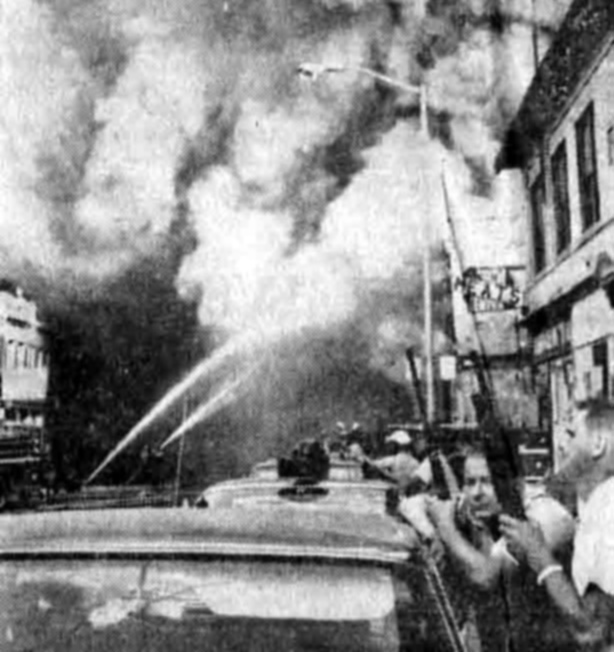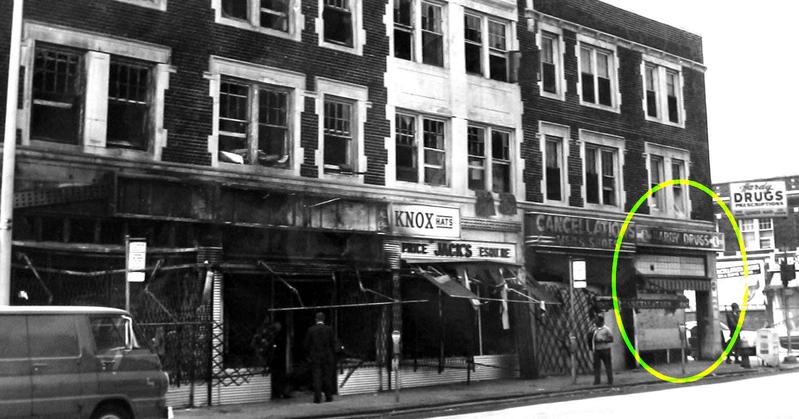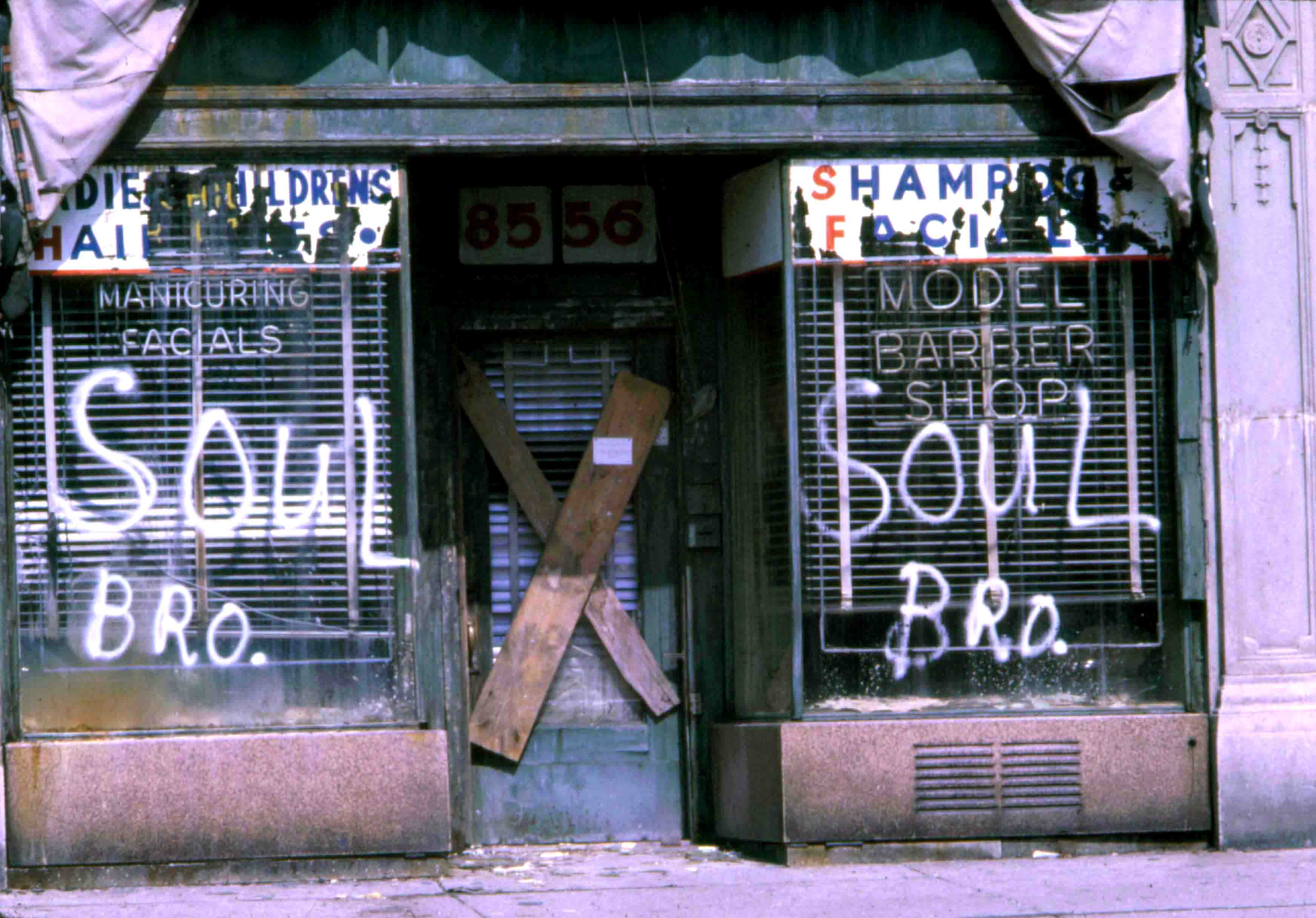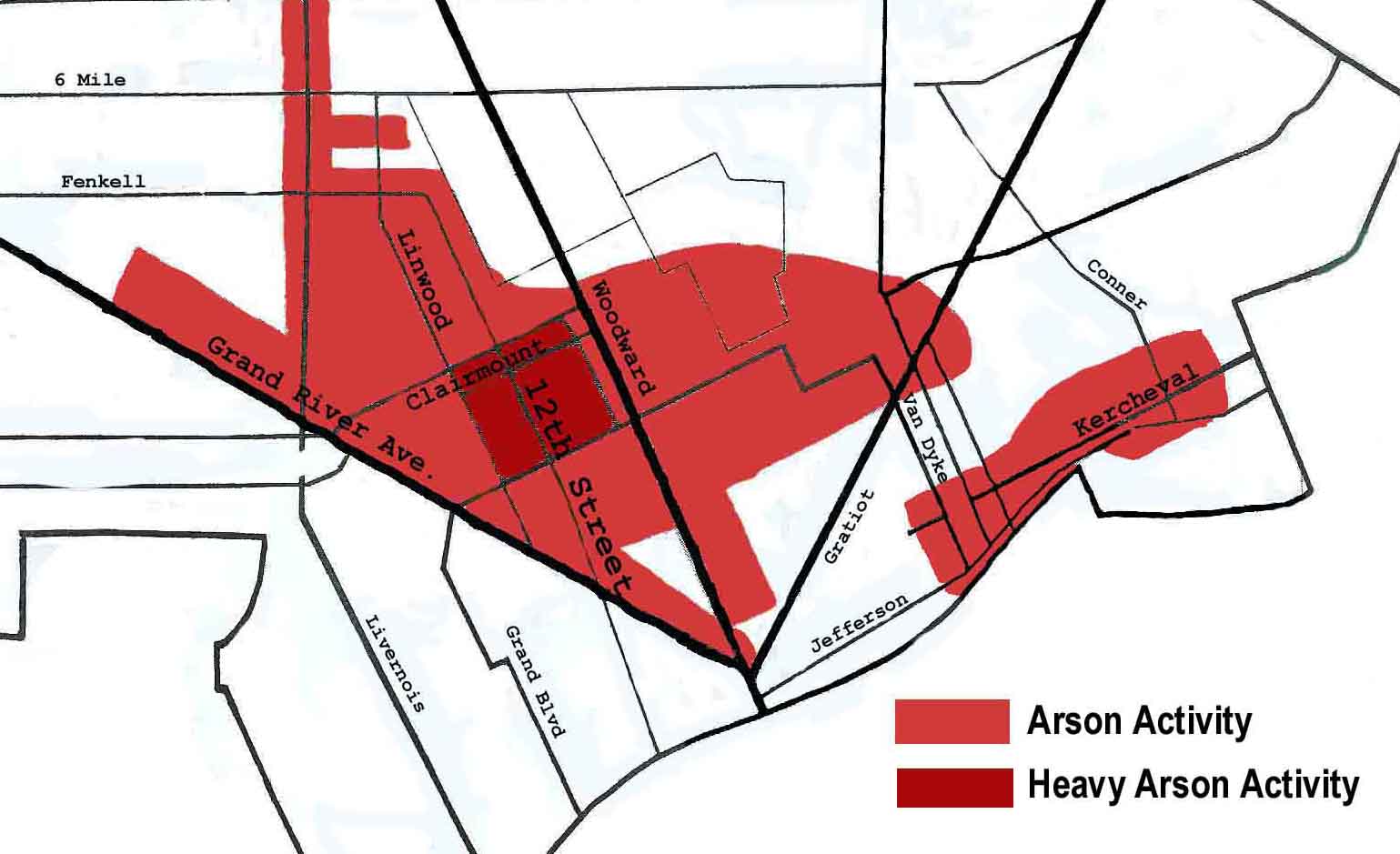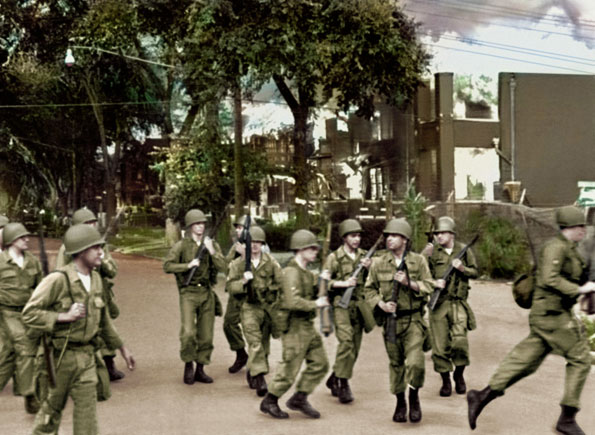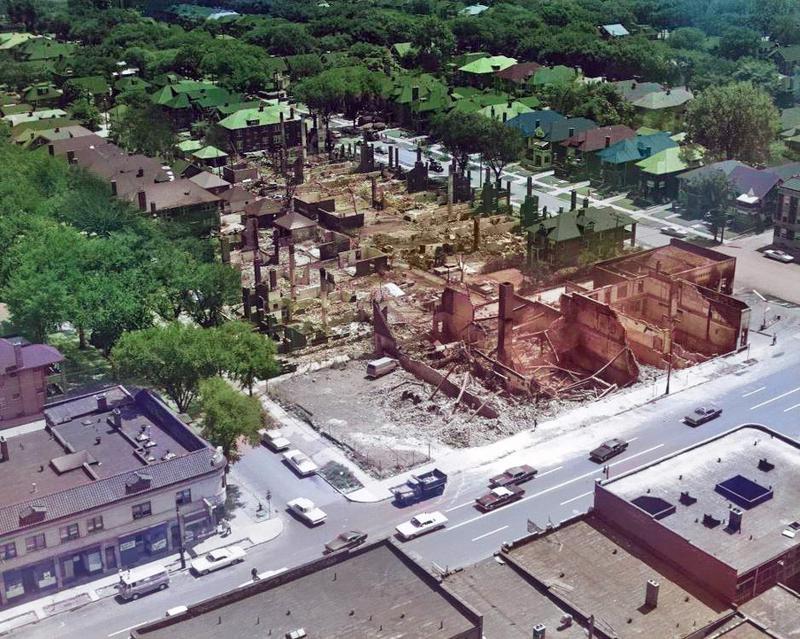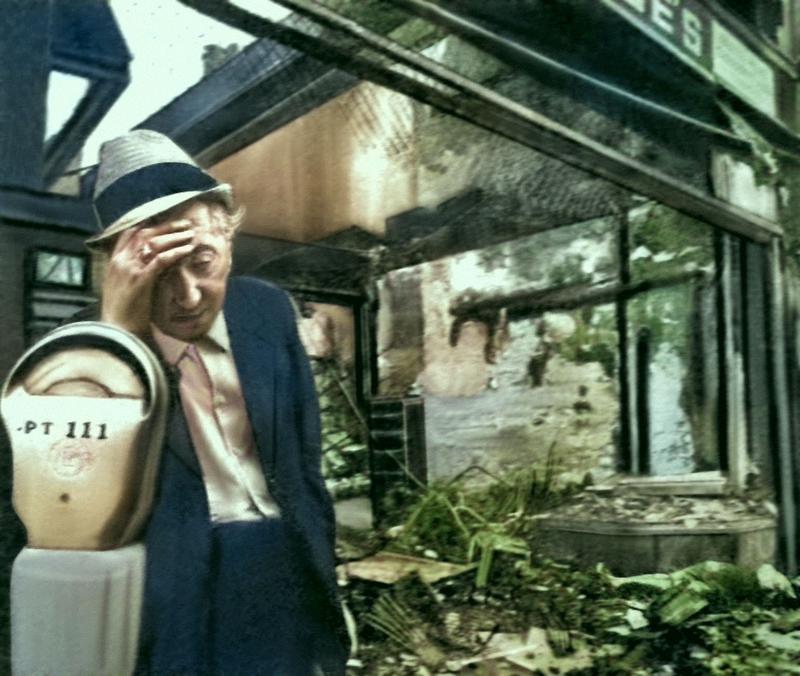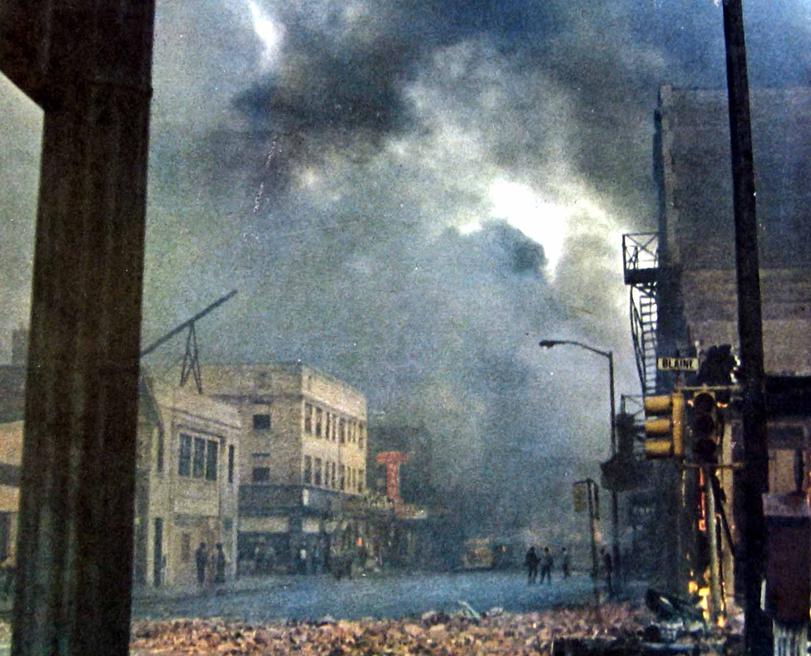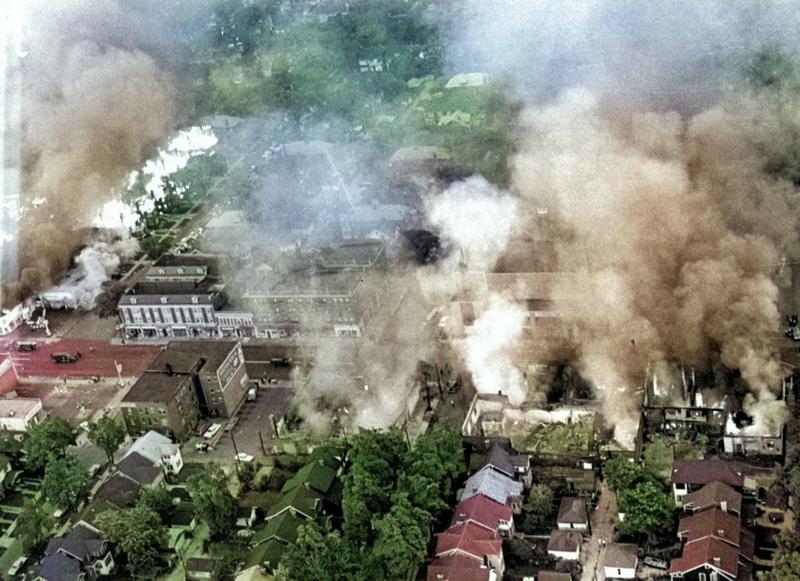Detroit - The Riot of a Thousand Arsons
"If you can't take it, burn it."
noise woke up the whole neighborhood, many of whom now poured out onto 12th Street to see what was happening. A staggering 1,300 more fires would follow in the next four days, many of which, under normal circumstances, would have been considered multi alarm fires were fought by single engines.
Detroit police, many of whom were off duty or away on vaction, hurried to the scene still in there civilian clothes to protect firemen from rioters.
Detroit was shrouded in a pall of acrid, blackish gray smoke which could be seen from as far away as Grand Blanc.
Hardy Drugs (circled) was the first store looted and put to the torch. While some arsonists did specifically target white store owners (Hardy drugs was black owned) who had failed to give them "the right measure" in the past, even a casual glance at the photo shows how many apartments sat above the stores, all crowded with people. It is a wonder the death toll was not considerably higher.
The New Front Line – The orgy of looting that took place the first day was quickly paralleled by an avalanche of arson. The DPD would soon share center stage to the DFD on Monday. The new front line was now manned by an army of weary firemen who steeled themselves to quench the firestorm that threatened to engulf the entire city. Scenes like this seemed reminiscent of Dante’s Inferno:
Without the assistance of the brotherhood of firemen, it might very well have been a repeat of 1803 when fire
destroyed the city of Detroit. Some 43 different communities assisted the beleaguered Detroit Fire Department in attempting to extinguish the conflagration that engulfed the city, including an engine from Windsor, Canada.
Birmingham
 Garden City Mut. Aid
Garden City Mut. Aid  Madison Heights
Madison Heights
 South Rockwood
South Rockwood
Clinton

 Gibraltar
Gibraltar


 Milford Twp.
Milford Twp.
 Southfield
Southfield
Commerce Twp. Highland Park
Highland Park

 Newport
Newport


 St. Clair Shores
St. Clair Shores
Dearborn

 Grosse Ile
Grosse Ile


 Plymouth
Plymouth


 Sterling Twp.
Sterling Twp.
Dearborn Heights Grosse Pte. Park
Grosse Pte. Park 
 Plymouth Twp.
Plymouth Twp.
 Taylor Twp.
Taylor Twp.
Ecorse

 Grosse Pte. Woods
Grosse Pte. Woods
 Pontiac
Pontiac


 Warren
Warren
East Detroit
 Harper Woods
Harper Woods

 Redford
Redford


 Wayne
Wayne
Eloise

 Harrison Twp.
Harrison Twp.

 River Rouge
River Rouge

 Westland
Westland



Ferndale

 Lansing
Lansing


 Roseville
Roseville


 Windsor, Ontario
Windsor, Ontario
Flint


 Hazel Park
Hazel Park

 Royal Oak
Royal Oak

 Wyandotte
Wyandotte

Garden City
 Livonia
Livonia


 Royal Oak Twp.
Royal Oak Twp. 

Many black business owners, sensing at first this was a race riot, let the rioters know their business was black owned. On Hastings Street in 1943 this technique worked. It was not to be in 67'. Some black owners, like their white counterparts, were also despised by their cliental. Also, because the buildings were so close together, the firebombing of an unpopular business often meant the destruction of those on either side even if they were well liked.
in the 1930s, were constructed to maximize space. Buildings were literally bricked up touching their neighbor so when fire breaks out in one, like filling an ice cube tray with water, the fire just spills into the adjacent buildings.
Flames from the litany of burning buildings turned the Detroit sky, fittingly it would seem, a blood red. “It looked like the whole world was on fire," remarked one stunned resident, "12th Street was burning. Guns were going off and electricity was popping all around. "
The Guardsmen, which by Monday numbered some 9,000 in the city (85% of the force) were now being assigned to ride along with the firemen for protection and attempt to counter the snipers and rioters.
Pingree Street off Linwood goes up in flames. This all started when an irate rioter tossed a fire bomb into the store on the corner because the store owner was disliked. As the 25 mile per hour winds pushed the flames eastward the fire spread from house to house, resulting
in the loss of most of the block.
The wretched aftermath of arson, the remnants of the Blaine - Linwood - Pingree block which was never rebuilt.
End of an era - Longtime 12th Street merchants like Joe Greenberg lost everything. Although the riot took many by surprise, insurance company's apparently saw through the veneer of tranquility. Many business's in the area had their insurance canceled in the months prior to the riot because insurance company's sensed the risk was just too great. Damage estimates initially went as high a 1 billion dollars in the post riot haze. A more reasonable estimate would be $200 million. The wholesale damage to the city's future, of course, was incalculable.
"The mid-day sun was hazy behind a canopy of smoke and ashes, giving the environment an eerie appearance of moon-lit medieval ruins. As I worked, the ruins in front of me took on the appearance of a face, a fearsome symbol of the God of Madness which seemed to be brooding over us all."
- Igor Beginin
Detroit artist and EMU professor Igor Beginin had witnessed tragedy before. As a boy in war torn Yugoslavia, he lived through the destruction and disorder of the Nazi occupation forces.
As the Detroit riot wore down, Beginin collected his easel and brushes and attempted to capture the chaos of the Detroit riot on canvass.
Guardsmen assemble amongst the chaos of arson as Blaine Street goes up in flames behind them.
Through me the way into the suffering city
Abandon every hope, yee who enter here.
